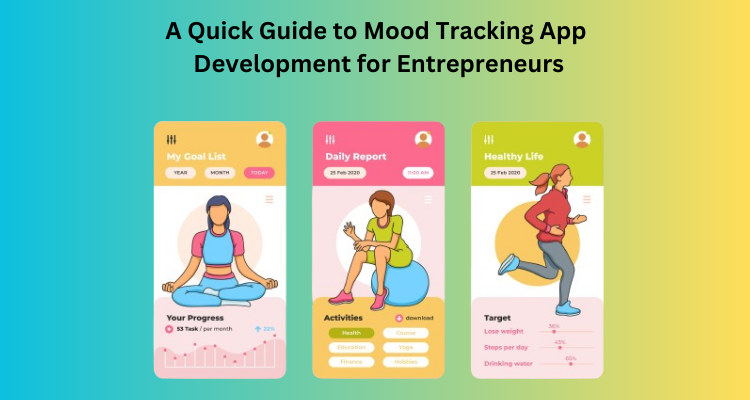
Over the last few years, there has been a higher emphasis on coming up with effective aids for emotional well-being owing to awareness of psychological disorders and susceptibility to stress. Of these, mood tracking app has received much attention as a tool. Thus, the mood tracker app development is one of the best prospects for business people interested in the mental health market. This guide aims to help those interested in mood tracker app development get as much fundamental information as possible on every step, from making the application for the given purpose to marketing it.
Understanding the Purpose of a Mood Tracking App
This FH Tech-designed application is uniquely designed to help users log their feelings over time. By recording daily moods, triggers, and behavior patterns, these apps help provide helpful information to manage a person’s mental health. The basic concept lies in monitoring personal moods and finding out what influences them, thus helping to make the right choices in mood.
For entrepreneurs, this presents a dual opportunity: topping many shareholders by coming up with a product that could fill the anticipated demand and, at the same time, help society in its little way. The overall topic revolves around the ‘mental wellness industry’. More specifically, it focuses on the role that mood-tracking applications have embraced.
Key Features to Incorporate
- User Profiles and Customization
Introducing the feature of users’ profile creation and management is mandatory. Personalization features increase user involvement and engagement and safeguard user’susers’ data. Primary data and preferences should be provided along with custom Mood-tracking options for the Profile. Users should be able to customize their mood scales and choose the tags they want to use. - Mood Tracking and Logging
Mood logging is the most crucial feature of a mood-tracking application since it tracks a person’s mood. Develop a graphical user interface where the users’ inputs are their current emotions. Several other self-report forms, including numeric ratings or general descriptors (e.g., happy, anxious, stressed), can be used. Enable the users to append some notes or comments that would give more meaning to their mood settings. - Analytics and Insights
It is essential to offer the users information about their mood tendencies. Build the features that would ‘draw’ reports with analytics in the form of graphics or charts to ease the understanding of common trends and patterns. For example, it should be possible to track mood changes over time and possibly some possible causes. - Reminders and Notifications
Pool, the app, is often used to set reminders and notifications. These can prompt users to log their mood at a particular time or alert them to check their mood. Users can select the type of reminder and the period they wish to receive it. - Integration with Other Apps
Think about linking your mood tracker with other health-related apps or calendars. This could benefit the users by giving them an outlook on their wellness. For instance, integration with fitness apps makes it easy to determine relationships, such as the effect that physical activity has on mood. - Privacy and Security
It is critical to pay close attention to privacy and security issues. People will disclose their moods, which will be personal and require enough protection to prevent leakage to the wrong parties. To ensure that users have confidence in the websites they are using, one ought to incorporate encryption, proper data storage, and the following data protection regulations.
Development Process
- Market Research and Analysis
It is advised to start with market research to learn what is current and what people expect. Analyze current mood-logging applications to see their advantages and disadvantages. This research should assist you in identifying areas of competition and thus point out where there is room for firms to innovate. - Design and User Experience (UX)
The appearance of your application is one of the most essential things that determines the degree of customer satisfaction. Pay more attention to the navigation on the website, as creating a customer-friendly interface is crucial. Always see to it that the mood-tracking method is easy to accomplish overall. Incorporating proper UX into the app will mean that people will have a reason to keep on using the app. - Choosing the Technology Stack
Selecting the proper technological solutions for your application is crucial for its creation and operation. Select suitable technologies that can implement the application’s functionalities and the number of users. Consider aspects like the platform (iOS, Android), the backend, and the data storage solutions. - Development and Testing
When the design and technology have been chosen, it is time to start the development process. Consult competent developers to create the app’s features and functions. Extensive testing is done to diagnose problems/bugs that might exist. During testing, usability, performance, and security features should be addressed since the user should not notice any issues. - Launch and Marketing Strategy
Marketing of the apps is a crucial step and an essential part of the successful launch of an app. Create a marketing strategy to help you advertise your app: social media, content marketing, and partnerships. Concentrate on the main attractions of the application so that potential audiences can be interested in it. It is vital to ensure that discounts or even subscription offers are made to ensure that many people download and use the apps. - Post-Launch Support and Updates
After your app has been developed, ensure that you care for it and make some improvements occasionally. The war against one’s reputation is waged online, and there is no way of avoiding it; therefore, I should monitor the users’ feedback and respond quickly if necessary. A constant update based on bits and bytes that will be received shall assist in maintaining the app as updated as possible while enhancing functionality. Updates add to the app’s improvements, guaranteeing users’ satisfaction and longevity.
Considerations for Success
- User Engagement and Retention
Emphasis must be placed on user acquisition and subsequent usage of the application. Embrace the elements that affect the clients’ engagement, including game elements, preferential offers, or online communities. The app should be updated frequently, whether with new features or overall content, to retain users. - Monetization Strategies
Understand the options available on the market to monetize the app so it can generate revenue. Some usual practices are providing the application with additional features for a fee, using a subscription model, or relying on ad revenue. Select a monetization strategy that fits well with the app’s intention and users’ expectations. - Compliance and Regulations
Ensure that your app fully complies with all necessary rules and regulations, specifically with the laws now in force concerning protecting personal data. Coping with compliance benefits your users effectively avoids legal mistakes and maintains trust.
Conclusion
Mood tracker app development offers a unique possibility for entrepreneurs to contribute to mental health app development. By expertise in temper monitoring apps and incorporating essential capabilities, you can create a treasured device that meets users’ desires and enables them to control their emotional fitness. A well-planned improvement manner, effective advertising techniques, and ongoing support will set your app up for achievement. As you venture into this promising marketplace, remember that your app can make a meaningful effect on customers’ lives, even while accomplishing enterprise growth.



